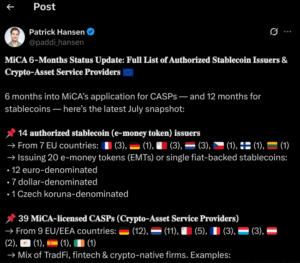The latest data shared by Circle’s EU Strategy Director, Patrick Hansen, shows that 53 institutions have obtained EU Markets in Crypto-Assets licenses (MiCA), of which 14 have been approved to issue stablecoins or EMTs. According to the breakdown on X, the 14 companies come from seven countries, including France and Germany. These companies issue 20 e-money tokens (EMTs) or fiat-backed stablecoins, which are denominated in euro, dollar, and Czech koruna.

39 MiCA-licensed crypto-asset service providers, including Circle and OKX, come from 9 EU/EEA countries, including Spain, Ireland, and France. Interestingly, Binance and Tether are not on the list. This comes just six months after the regulations took effect, signaling the momentum MiCA is gaining across Europe.
Why MiCA Licenses Are Pivotal
EU’s MiCA creates a harmonized framework for regulating crypto services across its member states. Obtaining a MiCA license unlocks many benefits for CASPs and users, such as investor protection and credibility. Under a single MiCA license, crypto firms can offer their regulated services to the entire 30-member European Economic Area (EEA).
For instance, a MiCA license obtained in a country like Malta grants the company access to all others, discarding the need for independent national approvals. Before MiCA, firms had to obtain separate national approvals, which hindered seamless cross-border expansion. Now, a MiCA license removes the logistics issues, as firms can scale Europe with minimal friction.
This move is cost-effective, time-efficient, and saves bandwidth for expansion. For the 14 stablecoin/EMT issuers and CASPs, the MiCA license gives them the legal backing to operate within the 30-member states without issues.
MiCA Licenses Offer Clear Rules for Institutions
One of the benefits of a MiCA license is its regulatory clarity. It offers clear rules for KYC/AML, reserve requirements, and oversight. Therefore, approved entities enjoy credibility and trust. Users are certain of better protection under the MiCA framework and can patronize the services of these entities.
Regulations also allow more institutions, such as banks, pension funds, and asset managers to enter the crypto space confidently. One of the trade-offs of investing in crypto was a lack of regulatory clarity and vulnerability to risks. With custodial frameworks, such as MiCA, institutions, and corporate bodies can enter the space knowing compliance is in the mix. This will increase institutional capital inflows in DeFi integrations and tokenized infrastructure across Europe.
With 20 tokens now approved, users can have wider access to tokens and trade them safely. Besides, these tokens are mostly EUR and USD-pegged stablecoins that hold full reserves and transparency. This minimizes counterparty risks and gives users full confidence to trade and hold these coins as assets.
Binance and Tether Still Without a MiCA License
World’s largest cryptocurrency exchange, Binance, and largest stablecoin issuer Tether, are yet to secure MiCA licenses, to the surprise of users. Tether’s USDT has even been delisted from exchanges due to a lack of compliance.
For a long time, Tether has been accused of manipulating reserves and issuing USDT unlawfully. The United States had asked the stablecoin issuer to provide a comprehensive audit report about their issuance, to which Tether has yet to respond. Without a MiCA license, USDT’s availability will be limited to users.
Binance is still working towards obtaining a full MiCA authorization, although the exchange has deleted some non-compliant stablecoins. It’s yet to be clarified if it will delete the remaining non-compliant tokens. The lack of a MiCA authorization will affect Binance’s operations within the EU.
Will Other Regions Adopt MiCA’s Framework?
With unified regulations, not only has the EU become a favorable destination for crypto projects, but MiCA may also establish global standards for regulatory oversight. Other jurisdictions, including the United States, may adopt similar frameworks in the near future. Furthermore, more CASPs and issuers may apply for MiCA to stay competitive and expand.




